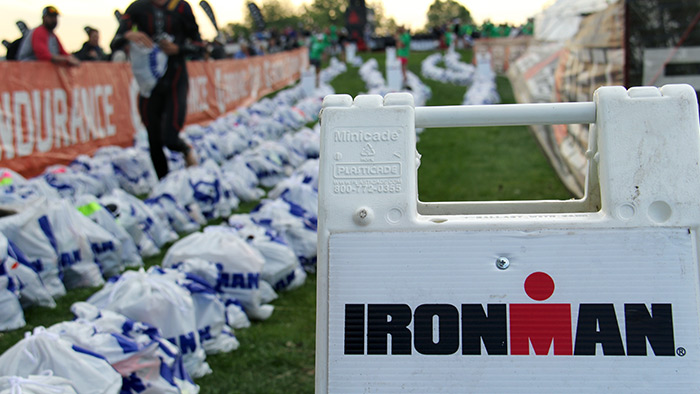Editor’s Note: The following charts and CTL® calculations were originally introduced by Jim Vance, coach and author of Triathlon 2.0: Data Driven Performance Training.
For many athletes, the very idea of racing an IRONMAN is daunting. The distances involved are so great that most athletes are overwhelmed and, as a result, tend to approach training with a very narrow focus (volume) while ignoring other important aspects of training.
Where to start? How rapidly should I progress? How much volume is enough? What intensities should I target? These are all questions that need to be addressed prior to creating an IRONMAN training plan, if one is to achieve success.
While focusing on being able to complete the distance may be appealing, it is only addressing one factor in the racing equation while ignoring perhaps the biggest contributor to IRONMAN racing success—intensity. If an athlete, or coach, truly wants to plan for a successful IRONMAN race, they will need to look beyond the volume approach.
Identify Your Sport-Specific TSS to Determine Your Goal CTL
This is where athletes can take their training to the next level by planning with Training Stress Score (TSS). TSS is calculated by combining the duration of a workout with its Intensity Factor® (IF), how hard the athlete worked compared to his/her functional threshold, or the maximum intensity that can be sustained for approximately one hour.
TSS allows an athlete or coach to compare the imparted training stress of workouts of different types, and even disciplines, on an “apples to apples” comparison. In this manner, overall training stress can be precisely controlled and allocated to areas that are most in need to elicit the biggest improvements in performance, without overreaching the athlete and risking illness or injury.
Because TSS is data driven, it is critically important to start off with complete and accurate data for Functional Threshold Power (FTP) or pace, as well as heart rate (HR) for each discipline (HR for swimming is not currently viable), and to test regularly to make sure your Training Stress Scores are accurate for the workouts throughout the training cycle.
Once you have reliable data to calculate TSS for your workouts you can start planning your training. The first step to successful planning of any kind is to identify both where you currently are and where you want to be at the conclusion.
I believe you should start your planning by having a target fitness level for race day. When using the Performance Management Chart (PMC), Chronic Training Load (CTL) is the measure of fitness you accumulated through your training—the six-week exponentially weighted average of your daily TSS.
You can look at past seasons and identify the CTL you achieved prior to a successful race to set a target, or, if this is your first IRONMAN race or you want to set a PR or take your racing to the next level, you can rely on general season targets that work for most, although not all, athletes (Figure 1).
These averages are sport-specific CTL targets, and are based on your cycling FTP for your bike CTL, and your running FTP (in kph) for your run CTL.
Swimming TSS is a more nebulous entity due to the variety introduced not only by technique, but also by the different conditions encountered in training – different pools, open water, temperature, drills, kicking etc., and should be determined in a more athlete-specific manner. Collecting and analyzing enough pace data from comparable pool training sets or open water swims will provide the best estimation of race day performance, CTL target and TSS for the swim.
Figure 1 Peak CTL guidelines for athletes depending on their goal (rFTPa in kph)

Credit: Triathlon 2.0 by Jim Vance
Determine Your Goal Race-Day CTL to Plan Your Training
Once you have your race day CTL Target, subtract your current CTL from it to identify your required CTL gain, then divide that number by the number of weeks to race day to determine your weekly CTL gain.
You now have overall and sport-specific weekly TSS targets to structure your training. At this time, you will also get your first important feedback in the form of the answer to the question, “Is my goal reasonable given my current fitness and the amount of time I have available to prepare?”
If your weekly CTL increase (known as your ramp rate) is within the accepted norms (Figure 2), then it is fair to say you can expect to achieve your goal with minimal risk of illness or injury from overdoing it. If it is far above that, then you will have to re-evaluate your CTL goal.
Ramp rates are individualized and dependent on past training, athlete level and goals as well as injury proclivity, although I’ve found that rates of 5 to 8 per week work for most athletes. Below that and your training is probably lacking structure and focus. Much above that and you risk injury.
Figure 2 CTL Ramp Rate guidelines based on risk of injury.

Credit: Triathlon 2.0 by Jim Vance
Using TSS/CTL Targets To Plan Specificity IRONMAN Training
Once you have calculated your CTL gain and weekly TSS targets, it’s time to start planning the specifics of your training. Depending on an athlete’s starting point, it may become apparent that one sport might need more focus than another, allowing for a very precise and efficient TSS allocation to achieve the required fitness gains without overloading the athlete and risking injury.
You should consider that 1 point of CTL is not equal among the three disciplines. Due to the weight bearing nature of running, running CTL is harder on the body than an equal amount of Cycling CTL, which is more impactful than a comparable Swim CTL. As a result, ramp rates may vary greatly among the three disciplines.
It is a good idea to incorporate race specific stress in training early on, provided the athlete has the fitness to handle the training load. TSS allows you to impart that specific stress rather than focusing on much less precise time or distance measures.
The bike leg is the longest segment by far and it will also greatly impact your ability to run well in the marathon. As a result, preparing your body to handle the rigors of the specific effort should be a priority.
An IRONMAN bike leg will usually record approx. 250 to 300 TSS (you can approximate yours by using your FTP, IF and estimated finish time), giving you a target for a specific training stimulus to plan for. Initially this can be a low intensity long duration ride, and evolve to more closely mimic race intensity and duration as the training progresses.
Swim race TSS values are much lower given the shorter duration of an IRONMAN swim leg and can therefore be more easily achieved in training, allowing you to develop the tolerance required on race day. I would not recommend reproducing race day run TSS in training, given the increased risk of injury.
IRONMAN run TSS projections can be made based on training metrics such as Intensity Factor, Functional Threshold Pace, and the Mean Maximal Pace Curve after a race TSS ride. On average an IRONMAN run will vary between 190 and 250 TSS, depending on the athlete, while IF ranges are between 0.7-0.85. With this information, you can determine the appropriate IF, and thus pace or power, you or your athlete can hold off the bike and train to achieve that goal.
Adjust Your Plan as Needed Along the Way
This approach will quickly provide answers to some important questions. Is your target run pace too aggressive for you to sustain off the bike? Can you tolerate your bike race TSS after a race equivalent swim TSS? Is your nutrition plan sufficient for the projected race day TSS? Can your body absorb the nutrition under the specific stress? You will then be able to adjust your plan, as needed, well in advance of race day giving you the confidence that you have a solid and executable race plan.
Training for an IRONMAN is daunting, but the planning does not need to be. Planning using TSS based on your individual data will eliminate guess work, simplify your training and greatly improve the probability of reaching the start line with the fitness and confidence to have your best performance.


